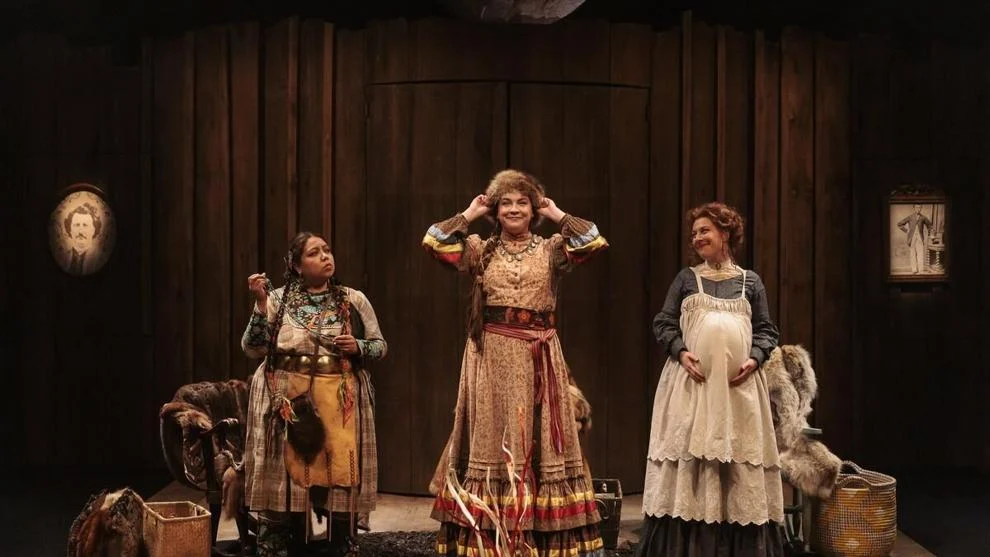

Women of the Fur Trade by Winnipeg-based, Anishinaabe/Slovene playwright Frances Koncan is a mixed blessing. On one hand, it is a cunning attempt to skewer accepted myths of Canadian history through satire; on the other hand, the play falters because it is too clever by half.
On the banks of a reddish river, in Treaty One Territory, in eighteen hundred and something-something, in Not Fort Gary-Fort Gary, sit three women in rocking chairs drinking tea. Each is of a different racial background.
Not once in the entire play is the fur trade mentioned, yet these three are women of the fur trade. It was, in fact, the fur trade that first brought the French and English into Indigenous territory which ultimately led to conflict over the land. Thus, it is the fur trade that is the driver of Canadian history, and this is the unspoken subplot of the play.
Métis Marie-Angelique (Kathleen MacLean) is obsessed with Métis leader Louis Riel (Keith Barker) and constantly writes him letters. Her dream is to meet her hero and join his rebellion/resistance. Cecilia (Jenna-Lee Hyde) is a pregnant English settler with a missing husband who has a not-so-secret crush on Irish Orangeman Thomas Scott (Nathan Howe). Ojibwe Eugenia (Joelle Peters), who actually has a job trapping and selling furs, is the only realist among the three because she is actually out and about, and a witness to history. She also writes astute and perceptive letters to John A. Macdonald.
The women sit under a ceiling of hanging portraits of famous, and not so famous, men. They gossip about doings in the fort – like Riel’s upcoming visit, they talk about their dreams, they complain about their problems, and they argue about the viability of the Métis fight to keep the land independent from the colonial powers.
One of Koncan’s themes is that it is the women of the west who kept life functioning as the men vied for power. It is their instinct for survival that underlies and supports history. It is they who represent Canada’s shared cultural inheritance, most notably, through their friendship.
The play belongs to Theatre of the Absurd. It is filled with anachronisms, such as language that is au current vernacular slang, with references to names like Truman Capote and Andy Warhol, along with aspects of pop culture. Although the women live over a century ago, they could be of today. Thus the very things they talk about could be happening now, and in fact, they are, in terms of the fight for Indigenous rights.
A major focus of the play is how Koncan toys with history. Thomas Scott functions as Louis Riel’s right-hand man, when in reality, Riel ordered Scott’s execution, which in turn led to prime minister John A. Macdonald sending troops to Manitoba, which in turn led to Riel’s execution. Having the two men as “frenemies” is the most absurdist occurrence in the play.
It is also Scott who answers Marie-Angelique’s letters when Riel ignores them. Thus these enemies are corresponding. A supporter of English settler expansion embraces the fervent passion of a Riel believer.
By reconstructing history, Koncan makes us look at Riel and Scott in a different light. Neither are heroes. In Women of the Fur Trade, Riel is more delusional than Donald Trump, while Scott is a nerdy fool who plays a losing hand. They may have made history, but as Eugenia points out, their history, and therefore Canada’s history, is based on bad decisions.
The play moves from absurdity to absurdity, and unfortunately, becomes too absurd. The humour diminishes in impact. There is no really satisfying ending. Conflicts hang in the air. The satire has run out of steam.
Director Yvette Nolan is arguably the most important Indigenous director in the country, and you can tell her heart is in this production. Characters are lovingly drawn. Relationships, particularly among the woman, are strong, while the cartoon men pale in comparison. It is an amusing contrast between the genders which the five-member cast takes delight in portraying.
As well, the production values are splendid, and Nolan’s vision would have propelled the look as symbols abound.
Samantha McCue’s clever set features a constantly burning log fire at the front of the stage, and when the women need props, they dig them out of the earth around the fire. Jeff Chief’s period costumes are gob-smacked gorgeous, particularly the stunning fur coats that the women wear. If anything, it is these sumptuous furs that provide the women with cocoon comfort. Michelle Ramsay’s lighting and Debashis Sinha’s music enhance the mood.
In short, Koncan’s Women of the Fur Trade is an important play of ideas, that ultimately sinks under the weight of too many ideas.
